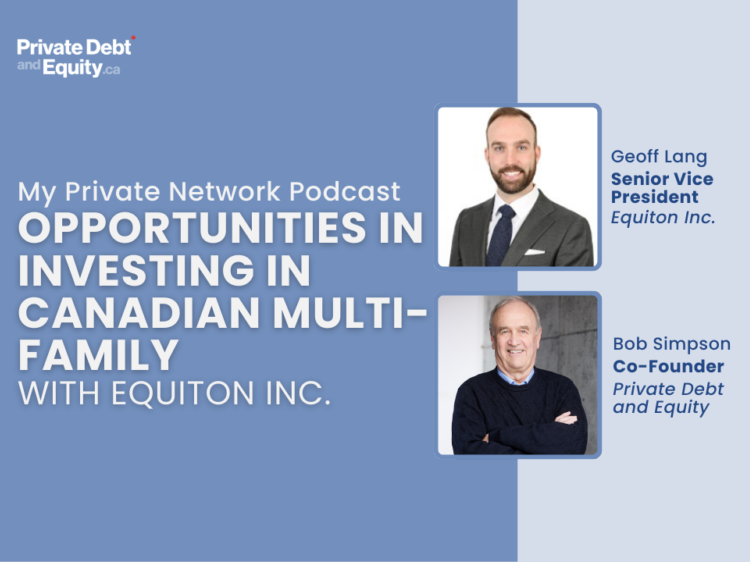Canadian Multi-Family Apartment Buildings has historically been a strong asset class for Canadian investors seeking strong, consistent, and predictable cashflows, asset growth and an opportunity to generate equity-like returns without the price volatility over medium to longer-term periods of time.
Suitability
Canadian Multi-Family is suitable for high-net-worth Canadian investors who have mid to long-term time horizons who seek potential double-digit returns, low volatility investments and the ability to defer taxes payable, as income is often through return of capital vs. interest income.
Why invest in
Canadian Multi-Family?
Professional Management
Multi-family apartment, as accessed through professional real estate portfolio managers, offer stable and predictable income streams backed by real estate assets.
Strong Demographic Support
Canada’s population growth has been strong, supported by immigration, with a strong demographic tailwind as Millennials (age approximately 17 – 37) is the largest demographic group, growing young families and need an affordable place to live.
Housing Shortages
Housing shortages in major cities across Canada combined with population growth and migration tilts the needle in favour of demand vs. supply.
Value Add Opportunity
A major advantage of multi-family is the ability of the operator to acquire buildings trading below market rents due to poor management and negligence and improve the quality of the building and units to make the building a better place for families to live and justifying higher rents. This is referred to as “Value Add”.
Consistent and Predictable Income
Monthly income streams and dividend reinvestment opportunities are generally available.
Registered Account Eligibility
Depending on the type of purchase, music royalties may be eligible for registered accounts (RRSP, TFSA, etc.)
Risks & Volatility
Understanding risks and volatility is critical to being successful investing in both public and private markets and both share similar risks, but others are quite different.
- Manager Risk
- There is always the possibility that a manager may make a series of bad investments or allow self-interest to put investment capital at risk. Through our due diligence and manager selection process, we work to minimize this risk.
- Liquidity Risk
- Investments in Canadian Multi-Family or other Private Real Estate are less liquid than traditional investments, such as publicly-traded equities and bonds.
- Private investments, such as private debt and equity, are not traded on public exchanges. Their valuation and trading occur less frequently and are often based on third-party valuations. This is advantageous as it removes investor stress caused by volatility of publicly traded securities, but investors should understand and be comfortable with pricing mechanisms.
- Investors may have limited options to sell their shares or exit the investment before the end of the investment term.
- Private funds can be “gated” (investors may be restricted or limited in their ability to add or withdraw funds) mostly due to high volumes of redemptions during short periods of time, which can last for long periods of time. This has happened when the reputation of the fund or manager comes into question or when significant losses are experienced.
- This lack of liquidity could result in challenges if you need to access your capital unexpectedly.
- Valuation and Transparency
- Investments in Canadian Multi-Family or other Private Real Estate are not subject to the same level of regulatory oversight and reporting requirements as publicly-traded REITs.
- This can lead to challenges in accurately valuing the underlying real estate assets and a lack of transparency regarding the financial performance and operations.
- Most Canadian Multi-Family opportunities use leverage to improve returns, which is normal in real estate investments.
- Limited Exit Options
- Exiting investments in Canadian Multi-Family or other Private Real Estate can be more complex and restricted compared to publicly-traded REITs.
- There might be restrictions on selling your shares to other investors, and the process could be subject to certain limitations or conditions, potentially impacting your ability to realize returns on your investment.
- To mitigate these risks, thorough due diligence and partnering with experienced management teams are essential.
- Volatility
- Private investments, such as private debt and equity, are not traded on public exchanges. Their valuation and trading occur less frequently and are often based on third-party valuations.
- This is advantageous as it removes investor stress caused by volatility of publicly traded securities, but investors should understand and be comfortable with pricing mechanisms.
Liquidity
- Liquidity can vary depending on the type of investment that you choose but investors should have a minimum two-to-five-year timeframe with potential early redemption penalties within the first six months.
Potential Returns
- Every investment has many moving parts so predicting the future should be used for estimation purposes only.
- Generally, target ranges for professionally managed multi-family investments are in the 8 to 12% range.
Taxation
- Income and growth generated by multi-family investments may be sheltered in registered accounts.
- For non-registered funds, income is generally in the form of return of capital which effectively defers tax until the investment is sold.


